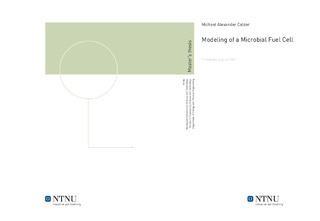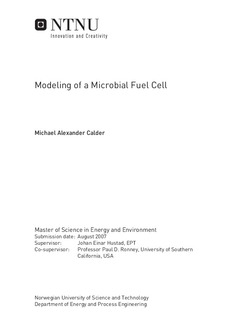| dc.contributor.advisor | Hustad, Johan Einar | nb_NO |
| dc.contributor.advisor | Ronney, Professor Paul D. | nb_NO |
| dc.contributor.author | Calder, Michael Alexander | nb_NO |
| dc.date.accessioned | 2014-12-19T11:44:19Z | |
| dc.date.available | 2014-12-19T11:44:19Z | |
| dc.date.created | 2010-09-03 | nb_NO |
| dc.date.issued | 2007 | nb_NO |
| dc.identifier | 347576 | nb_NO |
| dc.identifier | ntnudaim:3747 | nb_NO |
| dc.identifier.uri | http://hdl.handle.net/11250/233578 | |
| dc.description.abstract | It is clear that society worldwide must immediately begin to mitigate its environmental damage in order to sustain life on Earth. In this regard, researchers all over the global are exploring new energy efficient alternatives to power everything from cars to cell phones. The following brief describes research conducted on Microbial Fuel Cells (MFC) and its ability to utilize bacteria to produce electricity from biological masses for low energy consumer products While structurally the MFC is very similar to a Conventional Fuel Cell, the two systems have inherent differences that change the reactions, inputs and energy output. Currently, we have found MFC to produce only a fraction of the power (~1A/cm2 vs ~1mA/ cm2 ) produced by a conventional CFC, however, its versatility keeps MFCs as a promising fuel source potential. A Multi-disciplinary University Research Initiative has organized to examine and test the potential of MFC. The team is divided into three teams based on industry domains and expertise: microbiology, chemistry and electrochemistry, and engineering and modeling. The followin master thesis research was part of the engineering and modeling team lead by Professor Ronney XX. The goal of our team was to construct a first version of a computational model simulating the MFC system. The computational model is be based on combustion kinetics and a diffusion-reaction system theories, and is manipulated to immatate a biological system that can maximize its energy output. The model has been constructed in Fluent. Starting out with a 1D model, and consequently moved on to a 2D version. The final model is a diffusion-reaction system with 6 different species, a 3-step reaction, including a bacterial anodic oxidation, a cathodic reduction, and a possibility of taking into account a counteracting anodic reaction for oxygen crossover through the membrane. While the model has been proven to correlate well with lab tested experimental results, the team will continue to identify conditions to maximize the MFC s efficiency and energy output. | nb_NO |
| dc.language | eng | nb_NO |
| dc.publisher | Institutt for energi- og prosessteknikk | nb_NO |
| dc.subject | ntnudaim | no_NO |
| dc.subject | SIE5 energi og miljø | no_NO |
| dc.subject | Varme- og energiprosesser | no_NO |
| dc.title | Modeling of a Microbial Fuel Cell | nb_NO |
| dc.type | Master thesis | nb_NO |
| dc.source.pagenumber | 106 | nb_NO |
| dc.contributor.department | Norges teknisk-naturvitenskapelige universitet, Fakultet for ingeniørvitenskap og teknologi, Institutt for energi- og prosessteknikk | nb_NO |

